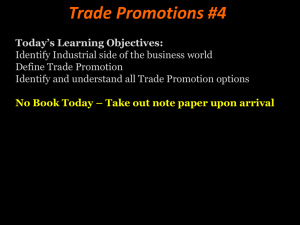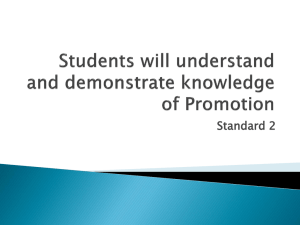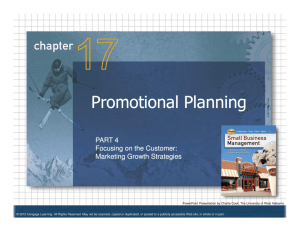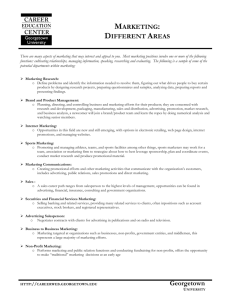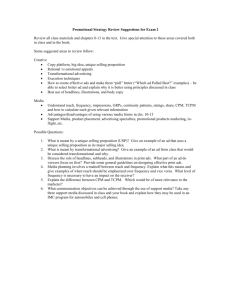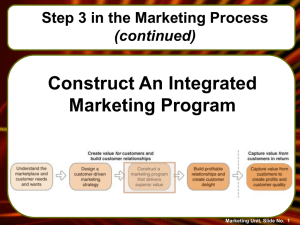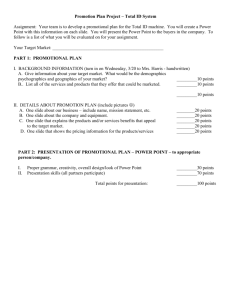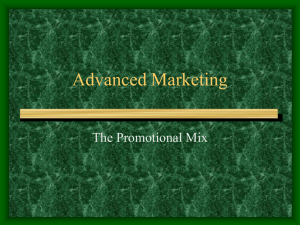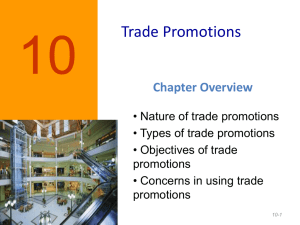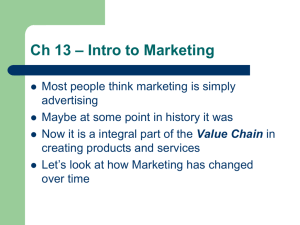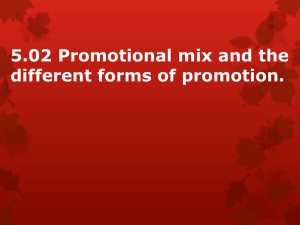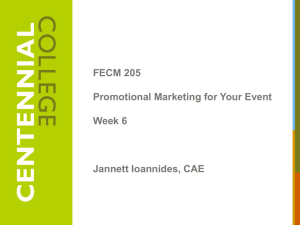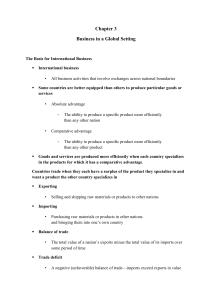Lecture 16 ItM Promotion
advertisement
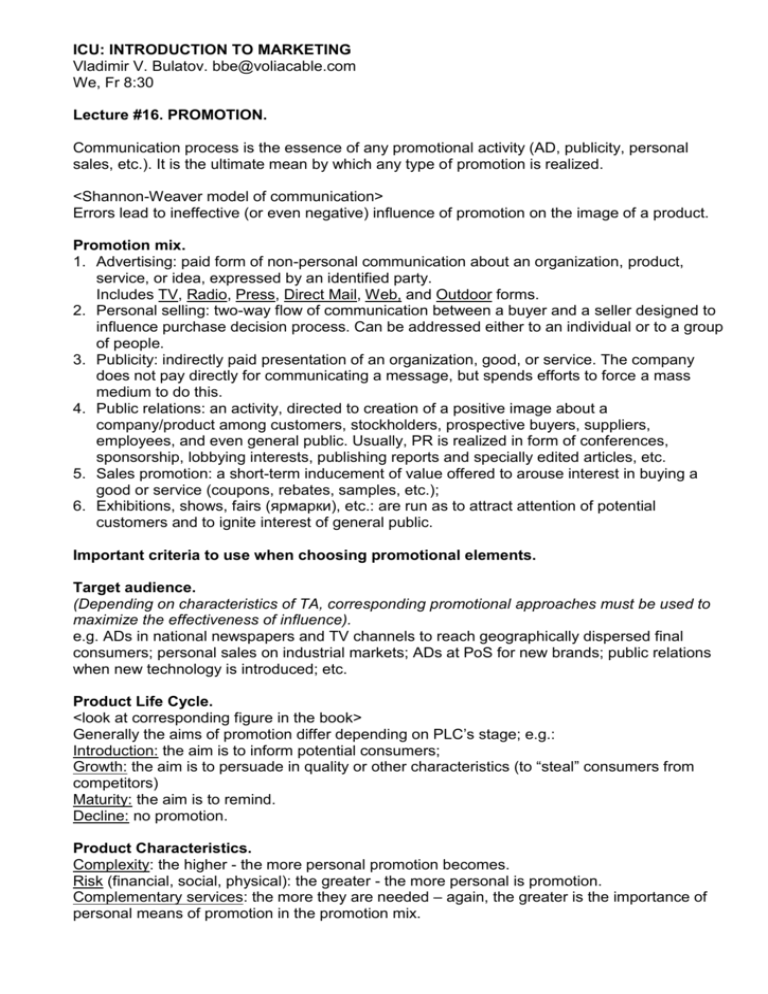
ICU: INTRODUCTION TO MARKETING Vladimir V. Bulatov. bbe@voliacable.com We, Fr 8:30 Lecture #16. PROMOTION. Communication process is the essence of any promotional activity (AD, publicity, personal sales, etc.). It is the ultimate mean by which any type of promotion is realized. <Shannon-Weaver model of communication> Errors lead to ineffective (or even negative) influence of promotion on the image of a product. Promotion mix. 1. Advertising: paid form of non-personal communication about an organization, product, service, or idea, expressed by an identified party. Includes TV, Radio, Press, Direct Mail, Web, and Outdoor forms. 2. Personal selling: two-way flow of communication between a buyer and a seller designed to influence purchase decision process. Can be addressed either to an individual or to a group of people. 3. Publicity: indirectly paid presentation of an organization, good, or service. The company does not pay directly for communicating a message, but spends efforts to force a mass medium to do this. 4. Public relations: an activity, directed to creation of a positive image about a company/product among customers, stockholders, prospective buyers, suppliers, employees, and even general public. Usually, PR is realized in form of conferences, sponsorship, lobbying interests, publishing reports and specially edited articles, etc. 5. Sales promotion: a short-term inducement of value offered to arouse interest in buying a good or service (coupons, rebates, samples, etc.); 6. Exhibitions, shows, fairs (ярмарки), etc.: are run as to attract attention of potential customers and to ignite interest of general public. Important criteria to use when choosing promotional elements. Target audience. (Depending on characteristics of TA, corresponding promotional approaches must be used to maximize the effectiveness of influence). e.g. ADs in national newspapers and TV channels to reach geographically dispersed final consumers; personal sales on industrial markets; ADs at PoS for new brands; public relations when new technology is introduced; etc. Product Life Cycle. <look at corresponding figure in the book> Generally the aims of promotion differ depending on PLC’s stage; e.g.: Introduction: the aim is to inform potential consumers; Growth: the aim is to persuade in quality or other characteristics (to “steal” consumers from competitors) Maturity: the aim is to remind. Decline: no promotion. Product Characteristics. Complexity: the higher - the more personal promotion becomes. Risk (financial, social, physical): the greater - the more personal is promotion. Complementary services: the more they are needed – again, the greater is the importance of personal means of promotion in the promotion mix. Stage of Buying Decision. Prepurchase stage: AD is definitely the most effective because it is the best mean to spread info quickly. Sales promotion may also have strong positive effect. Purchase stage: personal sales (either on industrial market or at PoS in a store) become the most influential/important mean of promotion. Pustpurchase stage: AD again becomes the core promotional element used to reduce cognitive dissonance. Also, additional personal contact may be an incentive for a client to repeat purchases in the future. Channel Strategies: Push Strategy: starts from retailers and personal sellers, who call on wholesalers to encourage orders and provide sales assistance. Wholesalers, in return, start to expose similar influence on agents or other wholesalers; eventually, agents push on manufacturer to (e.g.) decrease price and produce more. General goal is to force channel members to push “down” the product to THEIR customers. Pull strategy: used when manufacturers face resistance from channel members (they do not want to fill inventories, increase purchases, etc.). In this case manufacturers run promotional campaigns aimed at ultimate consumers, who, in response, start to ask the product from sellers. Seller, when facing increased demand, asks more of the product from upper members of the channel, what eventually leads to increase of production volume. Sales Promotions. A. Consumer-oriented sales promotions: - coupons; - deals (short-term price reductions to increase trials or to retaliate against competitors actions); - premiums (2 packages for the price of 1: also used to retaliate competitors’ actions or to temporarily attract attention); - contests (“buy 10 packs and have a chance to win a big prize …”); - sweepstakes (лотереи); - free samples; - continuity programs (e.g. accumulating discounts); - rebates (return of money based on proof of purchase); (advertisement-like sales promotions): - product placement (e.g. Duracell battery exposed in the Matrix movie); - PoS materials. B. Trade-oriented sales promotions (oriented at wholesalers, retailers, and distributors): - Allowances and Discounts (e.g. for retailers in return for spent AD efforts): - Merchandise allowance (discounts on wholesaler’s price, offered to retailer, who runs a promotion campaign); - Case allowance (deductions from invoices or quantity discount during a specific period); - Finance allowance (paying retailers for anticipated spending on AD campaign). - Cooperative Advertising (when manufacturer pays a percentage of the retailer’s local advertising expense (e.g. 50%) for advertising manufacturer’s product). - Training distributor’s salespeople. <describe custom-made communication tools [e.g. white lightscreens, on which appear images when viewers turn their heads> ADVERTISEMENT. Product-oriented AD has 3 basic gradations: 1. Pioneering (informational). 2. Competitive (persuasive). 3. Reminding. Institutional ADs: 1. Advocacy (run to demonstrate the company’s attitude to certain issues [alcohol, motorbike driving, etc.]). 2. Pioneering institutional ADs (AD about a newly created company). 3. Competitive institutional AD (demonstration of advantage of one product class over others [e.g. promoting cotton instead of using other types of fabric; or Mac vs. PC]). 4. Reminder institutional advertisements (bringing company’s name to the attention of the public). Organizing advertisement campaigns resembles marketing management process: Planning Implementation Control Planning (Developing the AD program) 1. Identify target audience (who must be influenced? The audience is not necessarily the segmented audience, but can also be information gatherer, influencer, decision maker, purchaser, or user). Basically, the more information is available about target audience, the more effective AD campaign can be build. 2. Specifying AD objectives. Objectives depend on the hierarchy of effects a consumer goes through when acquainting with AD information: - awareness (consumer’s ability to recognize and remember a product or a brand); - interest (increased consumer’s desire to learn more about the features of a product or brand); - evaluation (consumer’s appraisal of the product or brand on important attributes); - trial (consumer’s actual first purchase); - adoption (repeated purchases). 3. Setting the AD budget (among plenty of approaches to building AD budgets, there are: - percentage of sales; - competitive parity (matching the competitor’s absolute level of spending or the proportion per point of market share); - everything, what can be afforded; - “objective and task” (determining AD objectives outlining tasks to accomplish the objectives determining the AD cost to perform these tasks). 4. Writing a copy (the message that will be exposed to the target audience). (Includes creation of a concept, which then is transformed into a finished message). Different appeals can be used to enhance the delivery of information, but the most influential ones are sex and violence. <other contrasting appeals are fear, humor, beauty, love, anger, etc.> <describe how published and video materials are produced for Ads> 5. Selecting the right AD media (the core aim at this stage is to maximize exposure on target audience simultaneously minimizing the cost). Alternatives include any means that may influence potential consumer’s cognition and perception about a product/company. 6. Media Planning (scheduling the time when different AD media will be used and different parts of a copy will be exposed). Implementation (Execution of an AD program) - spending money on doing the tasks that are scheduled in media plan. The preceding activity is pre-testing, when AD materials are tested on uniformity of perception, congruence, potential for consumer’s responsiveness, etc. Controlling (Evaluating the AD program run). Aided recall (a comprehensive test on determining what parts of AD messages were remembered by the public). Grouping the results afterwards shows what parts of the message were at most remembered. Unaided recall (when respondents are asked general questions about what they saw yesterday [e.g]. Recalls about the AD are then calculated) Attitude Tests, Inquiry Tests, Sales Tests, etc.
